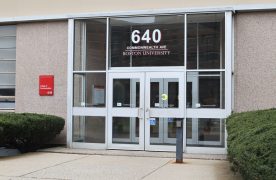On Sunday morning a friend and I went to eat brunch at a nice diner on Massachusetts Avenue. As we waited for a table to open up, we saw a large group of protestors advocating a greener future. At first, it struck me as strange that dozens if not hundreds of Bostonians were out in the streets due to climate change, but then I realized what was going on. They were not alone — all over the world, people are coming out to the streets to show their support for the climate change summit in Paris.
Since Monday, the leaders of 150 nations and representatives of the world’s other 46 countries have been meeting to work out a global solution to restore our atmosphere to sustainable levels of greenhouse gasses. The meeting in Paris is the 21st annual Conference Of Parties (hence the name COP21), which is the United Nations’ way of uniting the world’s leaders to tackle this problem. COP21 is especially important because it is the first time that China and the United States have both shown any real initiative. Similarly, it will be used to determine at what temperature the international community draws the red line on global warming.
The best way to think about climate change is to understand that planet Earth is a bubble. This means that almost nothing inside the planet comes in or leaves the atmosphere, which is like the edge of a bubble. Even though gasses dissipate and things seem to disappear, they all stay within the planet’s atmosphere, inside the bubble. What we have been doing for about 200 years is taking carbon-based fuel and burning it. When we do that, the gasses released stay inside the bubble. Some of those gasses, known as greenhouse gasses, retain the sun’s heat, and their proportion to other gasses in the atmosphere controls how hot the Earth gets.
Obviously, the details about climate change are much more complicated, but the general idea is clear. As we have added greenhouse gasses to the atmosphere over the last decade, we have caused the planet to heat on average by about .9 degrees Celsius, The Economist reported. This might not sound like a lot, but according to the BBC, just the difference in climate since the 1980s has caused an area of sea ice 10 times the size of the United Kingdom to melt. It is important to keep in mind that any ice floating on water that melts will not increase sea levels because it is already displacing water. But this should give you an idea of how much ice is melting, much of which is on top of solid land, like in Antarctica and Greenland.
The problem is that even though we know about climate change and what causes it, greenhouse gas emissions have continued to increase on a consistent basis. The amount of carbon dioxide (one of the most common greenhouse gasses) and other gasses in the atmosphere has increased by a little less than 10 percent since 1995. Much of the emissions come from developing or underdeveloped countries.
One big obstacle in global emissions reform has been in developing nations, where leaders feel it is unfair that they be “punished” with more expensive industrial growth while Western nations had developed by using the same fuels that would now be limited. The fight was led by China, and for many years the Chinese ignored calls to reform their use of fossil fuels. The United States, with its large fossil fuel companies, also dragged its heels.
However, this meeting is different from those that came before. For starters, the three most powerful nations in the world — Russia, the United States and China — are finally in agreement that action must be taken against climate change. Similarly, this meeting does not seek to create caps on greenhouse gas emissions, but instead encourages each country to take action and do what they can to curb climate change. By doing so, they sidestep the debate question of why developing nations should bear the brunt of the economic consequences.
While I am hopeful that something will come out of COP21, there is still plenty of reason to be skeptical. The biggest problem is that we are not cutting down on our emissions enough. South Korea, which plans to cut its emissions by 37 percent by 2030, will at that rate still be emitting 81 percent more greenhouse gasses than it did in 1990.
Barring any major surprises, the most important outcome of COP21 will be the decision that two degrees Celsius above pre-industrial climate levels is the red line that humanity is unwilling to cross. This is the time for our leaders to show strength and put the greater good above anything else.










